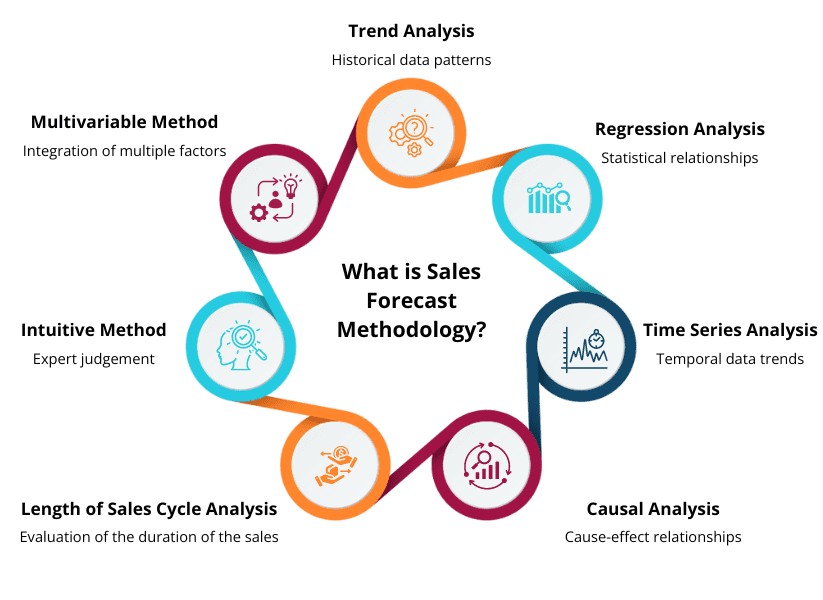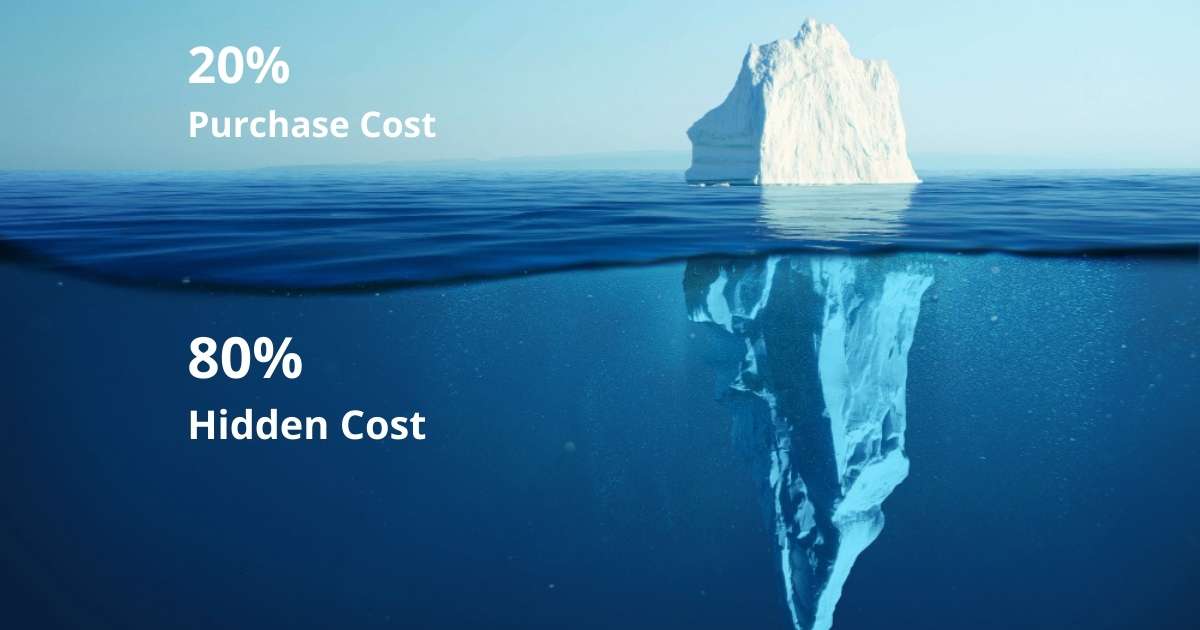What is Sales Forecasting?
Sales Forecasting is a crucial activity carried out by the marketing and sales department of the company to predict the future sales of the company’s products & services through a comprehensive analysis of past sales, historical data, and market trends for the purpose of finding new opportunities, better resource allocation, risk identification & mitigation, and maximizing company’s profits.
Sales forecasting helps you understand how much sales you have in the pipeline, estimate production efforts, and identify problems in achieving sales quotas in advance. It is a forward-looking method of predicting the company’s future revenue based on anticipated sales in the next week, month, quarter, or year to plan businesses.
What is Sales Forecast Methodology?
The outcome of sales forecasting depends significantly on the selected sales forecast methodology. Here are a few common types of forecast methodologies.
1. Trend Analysis
It is one of the sales forecast methodology that analyzes various trends on seasonality, geography, target audience, etc. for revenue projection and tracking any potential performance changes. It gives companies insights into long and short-term performance. The trend analysis is more commonly used in the retail or wholesale sector where the company’s commercial success depends on its ability to maintain optimal inventory using inventory management software.
2. Regression Analysis
Companies use regression analysis sales forecast methodology to understand the impact of a sales technique on sales performance. It is more helpful when the organization needs a granular view of its sales efforts & identifies the internal and external factors affecting those. The regression technique is a trusted approach used by insurance companies in estimating metrics such as the credit health of policyholders or the possible number of claims that may arise in a given period.
3. Time Series Analysis
Time Series Analysis is another popular sales forecast methodology that uses data from various intervals or time frames to track changes that happened over time. Businesses can use data visualization to analyze seasonal trends and understand the factors causing them. Time series analysis is widely used in different sectors to predict sales patterns over seasons, cycles, and trends. The sequence of various points plays a critical role in the Time Series Analysis methodology.
4. Causal Analysis
As the name suggests, the causal method assesses and predicts the outcome of a market fluctuation on a company’s profit. This sales forecast methodology starts by analyzing the current state of the market and identifies the factors that can change future trends. This sales forecast methodology takes into consideration how specific factors affect the demand for a company’s products & services and thus impact sales. It is an important method that studies the relativeness among different market variables and demand for the product.
5. Length of Sales Cycle Analysis
This sales forecast methodology uses historical sales cycle data to predict the outcome of a sales effort, like the previous purchasing behavior of the customer. Accurately predicting the sales cycle can benefit both the sales representative and the customer. Since the method uses objective information like customer segmentation, product popularity, customer lifetime value, and geographic locations, you can observe the sales more accurately.
6. Intuitive Method
As the name suggests is loosely based on asking the salesperson about the prospect. Some managers follow the intuitive strategy as it gives them a first-hand account of the source closest to the customer. However, on the flip side, you may receive a generous estimate. Businesses use the intuitive sales forecast methodology if they feel analyzing historical data will not provide accurate results. It does not take the internal and external factors into consideration.
7. Multivariable Method
The multivariable sales forecast methodology is an advanced and sophisticated method of estimating sales that involves evaluating multiple associated variables. It uses predictive analysis that involves customer demographics, seasonality, economic indicators, marketing campaigns, product launches, competitor activities, etc. This sales forecast methodology considers multiple data points such as the length of your sales cycle, the type of opportunity, and so on.
Explain Sales Forecast in Five Steps
Managers involved in driving the company’s sales depend on forecasting methods to estimate future sales of the products and services. Sales forecast involves five steps.
1. Analyze Historical Data
These days, businesses use dedicated BI tools for analyzing historical data. They provide an excellent baseline for determining future sales goals. Gather data on the previous year’s data from the sales management. Once you have the information, calculate the sales rate to calculate sales per period. It will form the basis for future predictions.
2. Refine Forecast
After establishing the historical sales rate, you may modify the number based on any changes you foresee that will impact your sales values. These factors can be changes in product price, expected growth/decline in customer base, and inclusion of new channels or product verticals.
3. Anticipate Market Trends
You can’t accurately forecast sales unless you analyze the market trends and measure elasticity of demand. You must reflect on all the market trends to modify the number of your sales forecast, like any competitor going public, launching a new product, or planning expansion.
4. Monitor Competitors
It’s a common practice among companies to monitor competitors’ products, campaigns, and growth models that can impact sales projections through ERP implementation. This should include monitoring the major players as well as new entrants in the market to identify potential implications for your business.
5. Implement Changes
Once you have evaluated all the factors and quantified the events in your projection, you can implement changes in your plan. Listing all the factors that can impact your sales when you go to the market gives you a granular view of the market conditions.
Effective Strategies for Successful Sales Forecasting
As we already explain sales forecast in simple words above, let us discuss how the efficiency of a sales forecast methodology depends on multiple factors The following are the ingredients for a successful forecasting process:
1. Predictive Modelling
The role of predictive modelling in sales forecasting is paramount. The decision-makers should focus on deriving as much information as possible from different departments, including frontline sales, production, and marketing teams.
2. Data Analysis
In modern sales forecast methodology, data is critical for making accurate assumptions. Software applications such as ERP customer relationship management tools are the two essential instruments in the hands of sales managers allowing them to glean institutional data from multiple sources.
3. Real-time Monitoring
Technology facilitates real-time monitoring of the sales process, allowing informed decision-making. It ensures that timely action is taken to course-correct or re-forecast when a deviation is determined. This increases the competitive advantage of the company.
4. Single Data Source
You can’t possibly explain sales forecast unless it is backed by accurate data. Applications like an ERP integrate multiple departments into a collaborative platform, providing a single, trusted data source. Generating forecasts based on the data reduces the possibility of errors. Using a common data source improves alignment and speed-up the sales forecasting process.
5. Process Improvement
Using data and analytics improves the forecasting process, and makes it more refined and accurate. Fostering a data-driven forecasting method improves the accuracy of the model and aligns more with the organizational goals.
How is the Sales Forecasting Process Different from Demand Planning?
As we’ve already covered the sales forecast types and effective strategies, now let us have a look at the difference between the sales forecasting process and demand planning.
Sales forecasting and demand planning are two important aspects of a business. Although the terms are often pronounced side-by-side they are fundamentally different. Sales projection deals with the revenue side of the business, anticipating how much the company will sell.
In contrast, demand planning determines how much a company should produce or procure to successfully meet the anticipated demand in the market. Sales and demand planning together aid in complete business management.
Here’s the tabular comparison of the difference between both of these concepts:
| Sales Forecasting | Demand Planning | |
| Definition | Sales forecasting is the process of predicting future sales. | Demand planning is the process of predicting the buying patterns of consumers. |
| Objective | Predict sales volume and potential revenue generation | Ascertain demand for the company’s products & services |
| Duration | Short-term (Monthly/ quarterly) | Short-term or Long-term (monthly, quarterly, or yearly) |
| Data Source | Historical sales data, and market trends | Market insights, seasonal changes in the market & consumer buying patterns |
| Who handles it? | Marketing & Sales Teams | Supply Chain & Operations Department, Inventory Management Teams |
| Tools & Technology Used | Uses statistical models, trend analysis, and a comprehensive CRM & ERP tool | Uses advanced analytics, and Supply Chain modules in ERP |
Importance of Sales Forecasting
Now, let us discuss the importance of sales forecasting for modern-day businesses.
1. Strategic Decision-making
Sales forecasting enables companies to make significant changes to different business operations. For example, if the company is expecting lower demand for its products in the future, it can take appropriate measures to lower the manufacturing costs to avoid burning off its profit margins. Forecasting allows the managers to spot issues in the process and avoid or alleviate those on time.
2. Achieve Sales Targets
Many businesses across the world use a lead management system for better sales forecasting accuracy and alleviating the possibility of attaining sales targets. The forecasting strategy forms the basis of your entire marketing plan. The insights gleaned from the action lays the foundation for the company’s vision and aligns your sales team to achieve the target.
3. Allocate Right Budget
Another important of sales forecasting is that it helps allocate the right budget. Budgeting has a profound importance concerning cash inflow, outflow, and budgeting. By predicting short and long-term sales, forecasting helps the finance team plan profit and income flows.
4. Prioritize Prospects
Using sales forecast methodology you can determine how much prospecting you need to keep the sales pipeline in good shape. Forecasting allows you to reduce time on weak prospects that do not align with your products and services and focus on the better ones.
5. Understand Consumer Behavior
Another important of sales forecasting is that it helps anticipate consumer behavior and predict future sales. The marketing team can find new cross-selling opportunities, draft dedicated pricing strategies, and alter their product design to meet the changing consumer requirements.
Limitations of the Sales Forecasting Process
The sales forecasting process is not free of limitations. Here are some of its limitations:
1. Inaccurate Predictions
Irrespective of sales forecast methodology, it is nearly impossible to predict future sales with 100% accuracy. Despite best efforts, unpredictable factors like weather conditions, sudden changes in market trends, or shortages of raw materials can impact sales forecasts.
2. Data Accessibility Issues
Since predictive sales analysis depends on data, it may require significant data cleaning. Depending on the complexities and volume of data, it can be time-consuming. Furthermore, errors, typos, and data duplicity can lower the effectiveness of the forecasting process.
3. Higher Cost
Implementing forecasting techniques may increase your costs in procurement and inventories. However, investing in the right technology, staff, and techniques can improve forecasting accuracy and help optimize expenses. Small & medium-sized organizations may find it difficult.
4. Technological Integration
Another limitation of the sales forecasting process is that it requires the adoption of the latest technology and tools. This requires in-depth knowledge and building a structured plan for integrating different technologies and tools.
5. Personal Biases
The sales forecasting process is subject to personal biases. The marketing team engaged in sales forecasting may hold personal biases. Some employees may be too optimistic or pessimistic. This can lead to inaccurate and erroneous forecasts.
Final Words
ERP Software is a business planning and forecasting tool that streamlines various business operations and consolidates data from different sources to provide strategic insights for decision-makers. ERP’s ability to process historical data and anticipate demand shifts empowers businesses to face competition & gain an edge over their competitors.
Sage X3 is a highly popular strategic tool that is pivotal in helping businesses leverage modern technology, tools & algorithms to estimate future demand & demand patterns for their products & services. It helps them stay ahead of the curve by aligning their costs, budget & resources with market demands, and proactively planning their operations to stay ahead of the curve.
FAQs
1. What is the Definition of Sales Forecasting?
Sales forecasting meaning is that it is a process that involves accurately predicting future sales and revenue of a company based on analysis of historical data for sales strategy planning, resource allocation, production decisions, etc. The right forecasting method is critical for a business to anticipate and boost revenue from sales in the future weeks, months, or years.
2. What are the Two Common Ways of Sales Forecasting?
The two most common ways to forecast are bottom-up forecasting and top-down forecasting.
- Bottom-up Method: The predictive method to anticipate a company’s performance uses low-level data to calculate future revenue. It starts with information on customers and products and broadens up to measure revenue.
- Top-down Method: The top-down approach deals with high-level data to calculate revenue. The formula to estimate revenue using the top-down method is: Top-down = Total Addressable Market x Assumed Market Share Percentage.
3. Who is Responsible for Sales Forecast?
Primarily, a sales manager or an analyst is responsible for performing the forecasting activity. They would collect historical sales data for analyzing future revenue growth. Modern sales managers use various technologies & tools for collaborating, analyzing, predicting, and reporting sales.
4. What Is a Sales Forecasting Tool?
Sales management software is a powerful and dedicated tool that caters to the needs of sales managers for predicting future sales. Such software gives the sales manager a clear picture of the sales pipeline and process, individual representative performance, and deal status.
5. How Does CRM Benefits Sales Forecasting?
The CRM application is a tool that manages all your company’s interactions and activities with customers and potential customers at every stage. A CRM aids in sales prediction by offering insights on past sales funnels to predict the outcomes of future sales.








